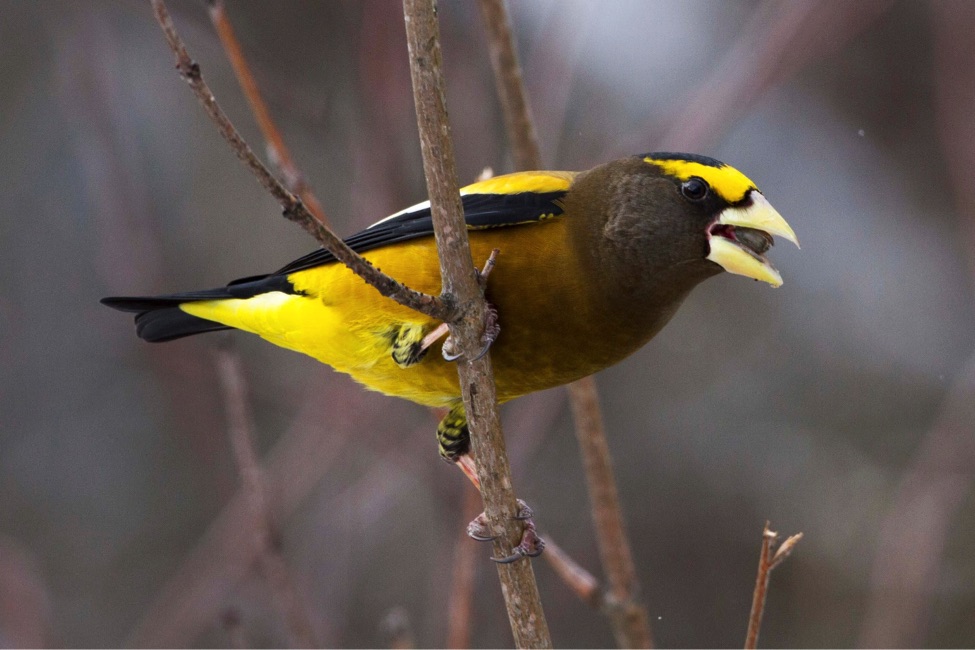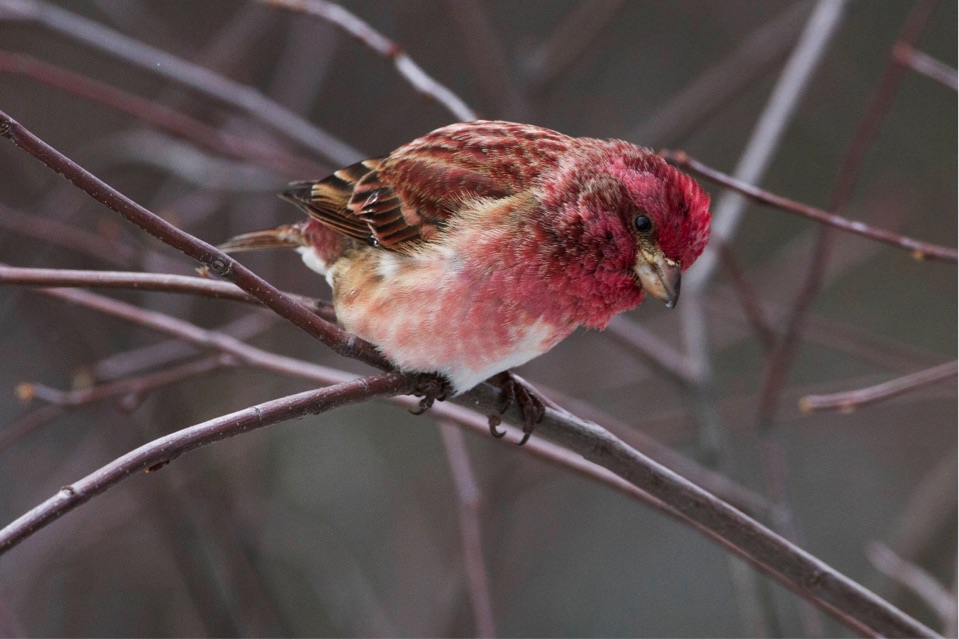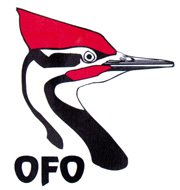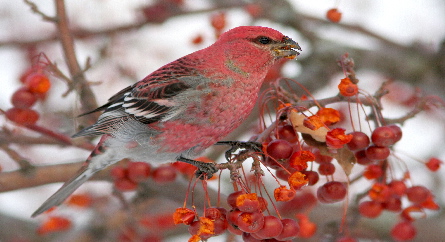INDIVIDUAL FORECASTS
Forecasts apply mainly to Ontario and adjacent provinces and states. Three irruptive non‐finch passerines whose movements are often linked to finches are also discussed. Follow finch wanderings this fall and winter on eBird.
PINE GROSBEAK
There should not be a flight of Pine Grosbeak south this winter. There is a good crop of Mountain Ash across the boreal forest. However, the crop appears to be a mosaic of poor to bumper crops scattered across the whole boreal forest. Small movements of grosbeaks wandering from areas with a poor crop in search of areas of better berry crop may provide birders with small numbers of the species outside the boreal forest. Individuals wandering southward will look for European Mountain-ash berries and small ornamental crabapples. At feeders they prefer black oil sunflower seeds.
PURPLE FINCH
The worst kept secret, most Purple Finches will migrate south out of Eastern Canada this winter. Reports of early movement of this species into the border states have been occurring for weeks. At the same time, one of our regular contributors reported abnormally high numbers of Purple Finches in Northeastern Ontario. While east at Tadoussac Quebec, good movements of Purple Finches southwestward are being observed. With Spruce Budworm outbreaks becoming widespread in the eastern boreal forest, the Purple Finches appear the to benefiting from an abundant food source during breeding season.
RED CROSSBILL
Red Crossbills are currently fairly widespread in Central Ontario to southern Maritimes and northeastern states mainly feeding in areas of heavy white pine crop. Red Crossbills should shift southward as the white pine crop is depleted. Don’t expect to see much in the way of any irruption from the west, but expect to continue to see numbers of Type 10 and very small numbers of types 1, 2 and 3 mixed in here and there. Types 2, and perhaps 4, should be a bit more common in the western Great Lakes States. The types are usually impossible to identify without recordings of their flight calls. Recordings can be made with a smartphone and identified to type. Matt Young (may6@cornell.edu or info@finchnetwork.org) will identify types if you email him your recordings or upload them to an eBird checklist. Recordings uploaded to eBird checklists are deposited in the Macaulay Library.
See Matt Young’s guide to Red Crossbill call types in the links below. I’m happy to announce that Matt and his team (myself included) have launched a new nonprofit organization dedicated to the study and conservation of finches: Finch Research Network (FiRN) - https://finchnetwork.org/
WHITE-WINGED CROSSBILL
The Crossbill Pendulum has swung west for the winter of 2020-21. An excellent crop of White and Black Spruce from northwestern Ontario to Alaska should contain the majority of White-winged Crossbills this winter. Throughout the boreal forest from Lake Superior, eastward spruce crops are mostly poor with areas of patchy fair crops and widespread fair Tamarack crops. Crossbills remaining in the East may move south of the boreal and areas with cone-laden spruces (all species) should be watched.
COMMON AND HOARY REDPOLLS
Common and Hoary Redpoll information has been affected by the pandemic. With travel to the north highly restricted due to the pandemic, widespread information on the extent of the Swamp Birch crop is limited. The little information that was gathered was of a heavy crop in northeastern Ontario. This birch crop could stop the redpolls’ movement south if it is extensive. The good news is the White and Yellow Birch crop is poor to fair throughout most of the boreal and southern Canadian forests. If the redpolls move on from the Swamp Birch crop, expect a moderate to good flight south out of the boreal forest. Watch for redpolls on birches, in weedy fields and at bird feeders offering nyger and black oil sunflower seeds. Watch for Hoaries in flocks of Common Redpolls. See link below for photos and identification marks of Common and Hoary Redpoll subspecies
PINE SISKIN
Large numbers of siskins are currently being reported in areas with excellent spruce crops in the western boreal forest. The siskins likely will remain concentrated in Western Canada with its heavy spruce cone crops for the winter. The smaller numbers remaining in the eastern boreal forest should move southward looking for food. At feeders they prefer nyger seeds in silo feeders.
EVENING GROSBEAK
This spectacular winter finch appears to be on the move this winter. Its breeding population appears to be increasing in Eastern Canada westward to Manitoba due to increasing outbreaks of spruce budworm with large severe outbreaks in eastern Quebec. Visual count observations by Tadoussac Bird Observatory in Quebec of grosbeaks moving primarily towards the southwest are reported to be the highest early fall numbers recorded in 25 years. Expect flights of Evening Grosbeaks into southern Ontario, southern Quebec, Maritime Provinces, New York and New England States, with some finches going farther south into the United States. At feeders they prefer black oil sunflower seeds. Away from feeders Evening Grosbeaks will look for maple and ash trees still holding keys. See link below for Evening Grosbeak Call Types.
THREE IRRUPTIVE PASSERINES
Movements of these three passerines are often linked to the boreal finches.
BLUE JAY
This will be an average to good flight along the north shorelines of Lakes Ontario and Erie. Beechnut and hazelnut crops are poor. The acorn crop is widespread ranging from poor to good in volume, with areas of the Adirondacks and Algonquin Park reporting a good crop of acorns.
RED-BREASTED NUTHATCH
This species has been irrupting south since mid-August and continues as this forecast is written. Individuals have made it as far as Oklahoma and Alabama. With cone crops in the eastern boreal forest mostly poor, expect this species to continue to move southward. At feeders, this species prefers black oil seeds, suet, and peanuts.
BOHEMIAN WAXWING
Most Bohemians will likely stay in the north because native Mountain-ash berry crops are good and other berry crops range from fair to good across the boreal forest. In recent winters, however, Bohemians have been coming south to forage on reliable annual crops of abundant Buckthorn (Rhamnus) berries. This species will also forage on planted European Mountain-ash berries and ornamental crabapples. Small numbers will probably arrive mid to late winter in traditional areas from Central Ontario eastward into the Maritime Provinces and northern New England.
Finch Information Links
1. Subspecies of Common and Hoary Redpolls – ID Tips and Photos.
http://www.jeaniron.ca/2015/redpollsRP.htm
2. Crossbills of North America: Species and Red Crossbill Call Types.
https://ebird.org/news/crossbills-of-north-america-species-and-red-crossbill-call-types/
3. Finch Research Network with finch species information https://finchnetwork.org/
4 Finch Facts, Seed Crops and Irruptions http://www.jeaniron.ca/2012/winterfinches.htm
5 Evening Grosbeak Call Types https://finchnetwork.org/species/grosbeaks/the-evening-grosbeak-project
Acknowledgements
A special thank you to Ron Pittaway for creating the annual finch report. We have benefitted from your contributions over the past 20 years. I look forward to the opportunity to continue the report moving forward and thank you for your contributions and guidance over the years.
I thank the many birders, naturalists, biologists, foresters and bear technicians whose tree seed reports allowed me to make this forecast: Charmaine Anderson (QC and Northern ON), Nick Anich (Northwestern WIS), Denis Barry (Algoma District and Durham ON), Dean Berezanski (MB), Jack Bowling (Prince George, BC), Ryan Brady (Northwestern WIS), Peter Burke (Algonquin Park ON), Mike Burrell (Eastern ON), Gray Carlin (Northern ON), Geoff Carpentier (Durham Region ON), Joan Collins (Adirondacks NY), Sam Collins (Central ON), John Cordon (Flin Flon MB), Pascal Côté (Observatoire d'oiseaux de Tadoussac QC), Michael Dawber (Rainy River District ON), Bruce Di Labio (Eastern ON), Carter Dorscht (Algoma and Kenora Districts ON), Jessé Roy-Drainville (Gaspesie QC), Bob Dunlap (Eastern MN), Dave Elder (Atikokan ON), Harold Fisher (Prince Albert SK), Marcel Gahbauer (Eastern ON), Bill Gilmour (Presqu’ile Provincial Park ON), David Govatski (NH and VT), Joe Gyekis (PA), Danica Hogan (NWT), Susan Kielb (Upper Pennisula MI), Bruce Mactavish (Newfoundland), Micheline Mamone (Nipissing District ON), Larry Master (Adirondacks NY), David McCorquodale (Cape Breton Island NS), Stacy McNulty (Adirondack NY), Bruce Murphy (Hilliardton Marsh Research & Education Centre, Timiskaming District ON), Stephen O’Donnell (Parry Sound District ON), Henrique Pacheco (Algonquin Park ON), Mark Peck (Haliburton ON), Justin Peter (Eastern QC, Central and Eastern ON, and Edmonton AB), Newton Philis (MB), Fred Pinto (Nipissing District ON), Timothy Poole (MB), Brian Ratcliff (Lake Superior and Northern ON), Michael Runtz (Algonquin Park ON and QC), Andrea Ruzzo (Algonquin Park ON), Peter Simmons (Algonquin Park ON), Doug Tozer (Algonquin Park ON), Ron Tozer (Algonquin Park ON), Declan Troy (Anchorage, Valdez and Interior AK), Angie and Ken Williams (Smooth Rock Falls ON) and Matt Young (NY). Thank you to Mark Peck for providing the photos. Susan Hall, Jean Iron and Ron Pittaway proofed the forecast.
22nd Annual Winter Finch Forecast
The first was posted to the
Ontbirds and
Birdchat listservs in 1999
Tyler Hoar Ontario Field Ornithologists, Oshawa, Ontario, September 20 2020

Evening Grosbeak at Algonquin Park by Mark Peck



